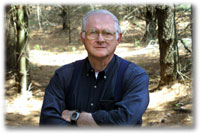A column from yesteryear
Thursday, March 16, 2023
Feet Touching The Ground
Thursday, March 09, 2023
MARCH SNOW MELT
One year Pa suggested we make a little waterwheel and place it in the melt water river. He made the waterwheel from a cedar wood shingle. He cut two pieces, each about three inches long and a half inch wide. He notched the two pieces and pushed them together making a waterwheel with four little paddles. With two other pieces of shingle wood he made a little frame that held the waterwheel in place while the running melt water turned it.
In early morning, when the temperature had fallen below freezing, the little waterwheel hung motionless in its frame, but usually by mid-day, with climbing temperatures and more snow melting, the waterwheel turned furiously, making a “flip ,flip” sound. The waterwheel turned for more than a week; Pa, my brothers and I would stop, watch and listen to it as we went about doing our various spring chores.
One warm, late afternoon day, we noticed the melt water river had stopped running and the water wheel no longer turned. On that day we knew that spring arrived.
THE OLD TIMER SAYS: Oft times the little things in life can provide the most pleasure.
Thursday, February 23, 2023
A blog I wrote in November, 2015
The Demise of the School of the Arts
An old
friend left us this past week. The more than 50-year old School of the
Arts held each year in Rhinelander, WI and sponsored by the University of
Wisconsin-Madison, is no more. Robert E. Gard was largely responsible for
starting the school. Bob’s philosophy was—the arts are for
everyone. No matter what your income level, where you lived, or how much
formal education you had.
I
attended classes there in the 1960s when I had the opportunity to learn from
Bob Gard. I participated in a fiction writing workshop with August Derleth, and
learned basic skills about writing a novel that have proved invaluable.
And much more.
Then in
1971, Bob Gard asked me to teach at the School of the Arts. I did this
for 32 years. It was there that I met such national writing figures as
Archibald McLeash (three Pulitzer prizes), Dale Wasserman, Henry Mark Petrakis,
Studs Terkel, Robert Bly and Jesse Stuart, all writers of considerable note.
All of whom taught workshops.
But now
the School of the Arts is dead. Many of us are mourning.
Mark
Lefebvre, longtime friend of Robert Gard, said this about the school’s passing:
Learning about the demise of the School of the Arts is
hard. I broke down and cried. I thought of the many summers I spent
with Bob at the School of the Arts. I think of all the people whose lives
were awakened.
I think
of the extraordinary faculty who in that very special place made real magic
happen. Bob taught me so much, most of all, how the unexpected can happen
through simple belief. I am so disappointed these days with the
University of Wisconsin. Belief is no longer part of its
vocabulary. No greater writer than Archibald MacLeish came to
Rhinelander one summer. A sophisticated guy. He could not believe
the world he had entered. Imagine these "students" being
exposed to this man who could not thank Robert E. Gard enough for putting him so
close to the creative process.
Long may the banner of
The School of the Arts wave over the
battlefields of ignorance!
THE OLD TIMER SAYS: The arts make a life
worth living.
Friday, February 10, 2023
The Many Faces Of Snow.
A column from yesteryear.
Snow, for
all of its inconveniences—driving challenges, shoveling, and slippery
walking—also has a lot going for it. The obvious of course is the beauty
of a snowfall and the wonders of the countryside transformed from the drabness
of late fall’s browns and grays to a world of white. Snow also provides an
opportunity to ski and snowshoe and go sledding. And a chance to build a
snowman or a snow fort or maybe even experience a friendly snowball fight.
I did a
little digging, no pun intended, into the characteristics of snow, and came up
with some interesting information, at least interesting to me.
Snow is
not always white. It may also appear blue especially on a cold winter
night when the moon is out.
Most of us have experienced
how sound changes after a fresh snowfall. Sound is absorbed by snow,
muffling it. But when the snow becomes hard and crusty, the opposite
happens. Sound bounces off the snow’s surface and travels farther. Of
course we all know the sound packed snow makes when we walk on it, especially
on cold days when it creaks and crunches, and sounds like it is protesting our
presence.
Snow is also a great insulator. Fresh
snow is made up of from ninety to ninety-five percent air. Many animals
know about snow’s insulating qualities as they burrow into snow to keep
warm. Farmers know this as a good snow cover protects crops such as
alfalfa from “winter kill.” A good snow cover also keeps my septic system
from freezing—not a good thing as it happened a few years ago when we had a
stretch of below zero weather and no snow.
Snow also stores water. Ten-inches of
snow may equal one-inch of water. Or ten inches of snow could contain as
little as one-tenth inch of water. It depends on whether a snowfall is
enhanced by moisture from the Gulf of Mexico, or comes from the dry plains of
Canada.
This is probably more than you wanted to know
about snow, but I find it all interesting as we plow on into the new year with
many more snowfalls to come.
THE OLD
TIMER SAYS: Let it snow, let it snow. Nothing much we can about it anyway.
Friday, January 27, 2023
A Column from Yesteryear Horseshoes and Good Luck
.
